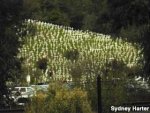Re: Nothing is Wrong and We're Going to Fix it
Here's the practical problem with your idea: Do you "protect" eastbound or westbound traffic with your crosses when putting them up on a really curvy road? Or do you put up two crosses for each death, one on either side of the curve?
Obviously, you put the cross facing the direction the person who died was coming from... I was thinking in terms of divided highways like interstates, If divers from both directions are involved, like on two lane roads, perhaps two crosses.
Your idea follows the typical "it won't happen to me"-logic where everybody wants to benefit from the crosses, wheras nobody wants to turn into a cross. I can think of a long list of reasons why you might have an accident while negotiating turns on a dark, narrow, slick and unfamiliar streach of road even if you are careful. To me, having road signs warning us of perils isn't any more unnatural than us driving big metal machines.
Of course we could just all drive 3 KM/h all the time...
No, I want to know where bad stuff happens precisely because I know it could happen to me (I totaled one car on the interstate so I know.). I would like real data, not just some government puke's opinion. We can benefit from both, you listen to your government advice, I'll weight that against what the history for that stretch of road says.
FWIW driving at 3 KM/h might not even work to eliminate all accidents. I recall driving on interstate highways probably designed for safe transit at 80 MPH back when we had a nationwide 55 MPH speed limit (to conserve fuel). It probably saved fuel, but I saw way too many drivers reading books or newspapers while they were driving. I recall personally having trouble keeping my mind from wandering with things happening that slowly. A 55 mph speed limit today would probably have drivers logged onto the internet and posting to threads like this while driving.
My suggestion to apply feedback where deaths occurred was independent of speed limit, but I guess faster drivers could use this to know where they might want to slow down. It is a fact of life that most roads have dangerous places, why not help history advise us? "Danger, something bad happened right here.. multiple times in fact".
Studying history to not repeat other's mistakes is a good thing. IMO
JR
PS Sorry about feeding the veer...

